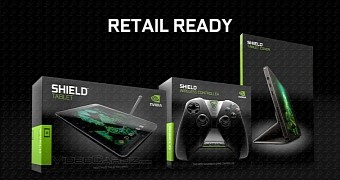Earlier today we told you that NVIDIA’s latest Shield gaming tablet just received its first OTA update, which brings about some stability and performance improvements.
For the time being customers looking to purchase the tablet are invited to grab the Wi-Fi only model with 16GB of internal storage, which sells for $299 / €227.
But back when it announced the tablet, NVIDIA also said that a 4G LTE model with 32GB of storage would be made available for $399 / €303.
Now a device matching these characteristics has been spotted making an appearance at the FCC. This event is a good indication that the slate will soon make it into retail.
For those of you who haven’t been following the story, the Shield Tablet represents NVIDIA’s second attempt at building a slate.
The device arrives with an 8-inch screen and offers 1920 x 1200 pixel resolution, which is an improvement from the earlier model.
The tablet runs on NVIDIA’s latest 2.2GHz ARM Cortex-A15 quad-core processor with 192-core Kepler graphics. Moreover, the system bundles 802.11n 2x2 Mimo dual-band Wi-Fi, Bluetooth 4.0, HDMI output and support for 4K HD video playback.
It also has two 5MP cameras, front-facing speakers, and takes advantage of NVIDIA’s own DirectStylus technology.
In the US, the LTE-enhanced version will probably be offered under the AT&T banner and we think the announcement from the carrier will come soon.
The Shield tablet is NVIDIA’s attempt to make the tablet gaming popular. Before you say anything, you should know the company does not offer the device as a standalone package.
Gamers have the opportunity to pair the slate with a wireless controller and you can also get an optional case to be used as a stand.
Anyway, even if on paper everything sounds nice and dandy, before purchasing a Shield tablet you should take a minute to go through one of our previous articles, where we draw attention that some users have been complaining their almost new tablets are starting to crack.
Surely, the issue is of a cosmetic nature and won’t really affect performance (at least for the time being), but if the tablet is faced with such faults at this early stage, who’s to say of what lies beyond.
NVIDIA has been made aware of the problem, and while the company doesn’t see the problem as being of cataclysmic proportions, it has offered to replace the affected units free of charge.
So if you are currently the owner of a damaged tab, contact your local re-seller to see how you can get the problem fixed.

 14 DAY TRIAL //
14 DAY TRIAL //